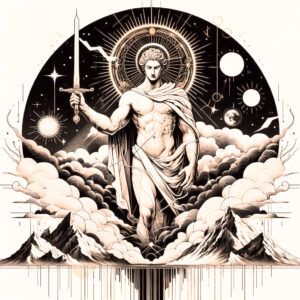
CONCEPT:
Navadurga
Pronunciation:
/nɑːvədʊrɡɑː/
Definition:
Navadurga refers to the nine forms or manifestations of the Hindu goddess Durga, each representing a different aspect of her power and personality. These nine forms are worshipped during the nine nights of Navratri, a major Hindu festival celebrating the divine feminine.
Other Concepts
Deeper Understanding
Navadurga, a profound concept in Hindu mythology, encapsulates the nine distinct manifestations of the goddess Durga. Each form symbolizes a unique aspect of her power, offering worshippers a diverse spectrum of divine qualities. These forms are particularly venerated during Navratri, a nine-night festival dedicated to the celebration of the feminine divine.
The Navadurga include Shailaputri, Brahmacharini, Chandraghanta, Kushmanda, Skandamata, Katyayani, Kalaratri, Mahagauri, and Siddhidatri. Each manifestation has its own iconography, mythology, and significance, reflecting different facets of Durga’s power and personality.
Shailaputri: The daughter of the mountains, Shailaputri represents nature and purity. She is depicted riding a bull and holding a trident and a lotus.
Brahmacharini: Symbolizing asceticism and devotion, Brahmacharini holds a rosary and a water pot, embodying the power of penance and meditation.
Chandraghanta: Known for her bravery, Chandraghanta has a crescent moon on her forehead. She is depicted riding a tiger and is ready for battle, signifying courage and strength.
Kushmanda: Representing the cosmic egg from which the universe was created, Kushmanda radiates energy and warmth, often shown with eight arms and a radiant smile.
Skandamata: The mother of Skanda (Kartikeya), Skandamata is a symbol of maternal love and protection. She is depicted holding her infant son and riding a lion.
Katyayani: Born from the collective energy of the gods to defeat the buffalo demon Mahishasura, Katyayani represents the warrior aspect of Durga. She is shown with multiple arms, each holding a weapon.
Kalaratri: The fiercest form, Kalaratri is associated with destruction and protection. With a dark complexion and a fearless stance, she rides a donkey and is depicted with a powerful, fiery aura.
Mahagauri: Symbolizing purity and tranquility, Mahagauri is depicted in white attire, riding a bull, and is often shown with four arms.
Siddhidatri: The granter of supernatural powers, Siddhidatri is worshipped for achieving spiritual goals. She is depicted sitting on a lotus or a lion, holding a discus, a conch, a mace, and a lotus.
The Navadurga are more than mere mythological figures; they embody profound psychological archetypes and cultural values. Each form of Durga encapsulates aspects of the feminine divine, from nurturing and maternal to fierce and destructive. This diversity of representation provides a rich tapestry of role models for women, offering qualities such as courage, resilience, wisdom, and compassion.
The historical roots of Navadurga are entrenched in Hindu mythology and scriptures, with each manifestation having unique origin stories that illustrate their divine roles in restoring cosmic balance. Durga’s role as a warrior goddess, particularly in her battle against demons like Mahishasura, highlights themes of good triumphing over evil, a narrative that resonates deeply within Hindu culture.
Scientifically, while the existence of deities falls outside empirical validation, the Navadurga hold immense cultural and psychological significance. They embody archetypal energies that resonate with human experiences, providing a framework for understanding complex emotional and spiritual dynamics.
The relevance of Navadurga extends into contemporary times, where they continue to inspire and empower. During Navratri, the worship of these nine forms is a time for spiritual reflection, inner transformation, and celebration of feminine divinity. This festival fosters a deeper connection to the qualities embodied by each manifestation, encouraging devotees to cultivate these attributes within themselves.
References
Kinsley, David. Hindu Goddesses: Vision of the Divine Feminine in the Hindu Religious Traditions. University of California Press, 1988.
Foulston, Lynn, and Stuart Abbott. Hindu Goddesses: Beliefs and Practices. Sussex Academic Press, 2009.
Coburn, Thomas B. Devi-Mahatmya: The Crystallization of the Goddess Tradition. Motilal Banarsidass, 1998.

